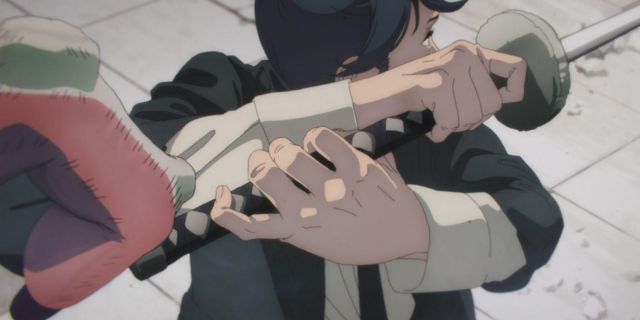Contains Spoilers For Chainsaw Man Episode 8, “Gunfire,” now streaming on Crunchyroll, Disney+ and Hulu.
Chainsaw Man’s Aki Hayakawa wields a mysterious bladeless sword that is eerily shaped like a nail rather than a traditional Japanese katana. His senior Himeno refuses to let him use it due to the fact that it takes years from the life of the user. This is due to the user of the sword having a pact with the Curse Devil. In return for a substantial amount of lifespan, the Curse Devil is summoned to bring about its power to the victim of the sword.
Aki is fairly confident in its ability to take down any devil that stands in the Public Safety Division’s way — and he’s right in that regard, as the curse is based on the real-life Japanese cursing ritual called Ushi no Toki Mairi, which is said to bring certain death to a targeted victim. This makes the pact with the Curse Devil one of the strongest powers in the Chainsaw Man universe.

Fans of Chainsaw Man first see the sword utilized by Aki in Episode 8, “Gunfire,” against an unknown powerful fiend during a surprise attack. Aki uses the sword by closing in on an enemy and aiming the sword at the target. He then calls out to the Curse Devil to plunge the sword into his victim with a flick of the Curse Devil’s finger. The Curse Devil counts down the times the sword is stabbed through the target, starting from three down to one. Aki then calls out to the Curse Devil to complete the curse, and the victim dies as a result of the Curse Devil’s power.
This mirrors the traditional Japanese cursing ritual called Ushi no Toki Mairi, thought to have been developed in the Edo Period. In Ushi no Toki Mairi, the curse victim is represented by a “wara ningyo” — a straw doll resembling a human, also known as an effigy. The wara ningyo is nailed onto a sacred tree by the practitioner, typically represented as a vengeful woman in Japanese historical works. These nails are meant to break the barrier between the living world and the spirit world. The practitioner must then call out to summon the evil spirits and demons of the spirit world into the world of the living to enact suffering onto the victim.
This ritual must be repeated on a daily basis, and the cursed person experiences unavoidable suffering in the form of illness or injury each day the ritual is carried out, eventually meeting a horrible death. Fascinatingly, some people in modern-day Japan still believe in the Ushi no Toki Mairi cursing ritual. Nonetheless, entering the premises of a shrine and nailing a wara ningyo onto a sacred tree will likely result in being charged with trespassing and vandalism.















Leave a Reply